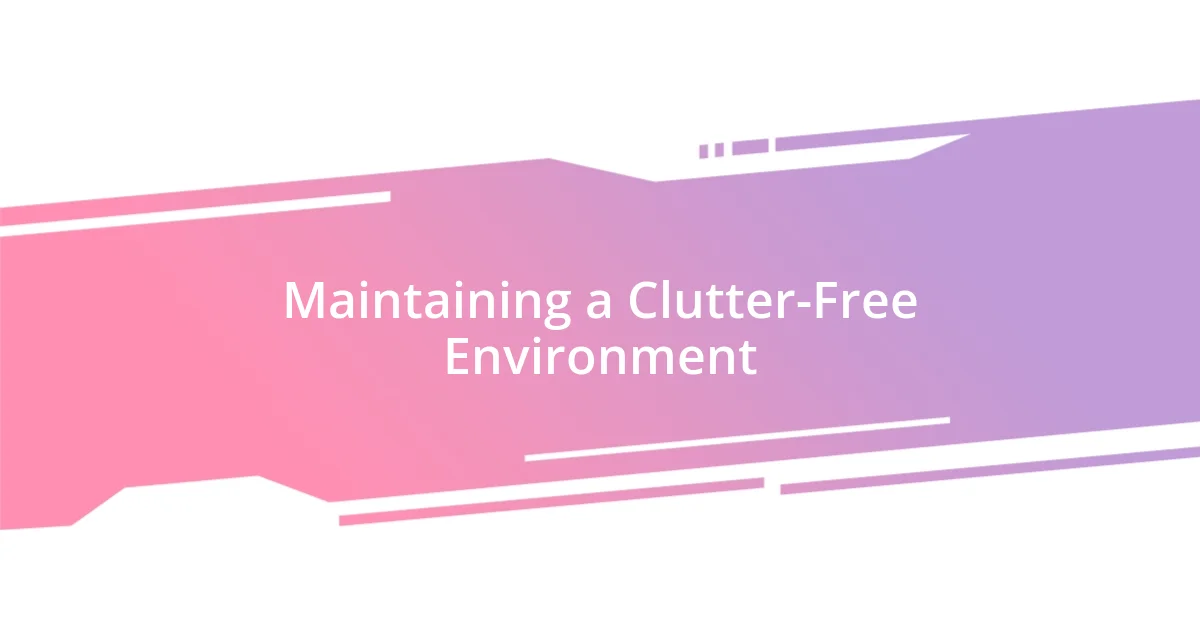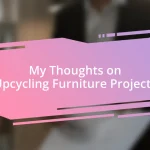Key takeaways:
- Decluttering enhances mental clarity, emotional well-being, and productivity, transforming one’s space into a more focused and peaceful environment.
- Identifying types of clutter (sentimental, functional, decorative, digital, and miscellaneous) aids in making informed decisions about what to keep or discard.
- Establishing a decluttering strategy with achievable goals and routines, along with consistent maintenance, helps sustain a clutter-free living environment.

Understanding Decluttering Benefits
Decluttering isn’t just about clearing physical space; it significantly enhances mental clarity as well. I remember the first time I tackled my overcrowded workspace. It was like lifting a fog that had been clouding my mind. Have you ever felt that weight lift after organizing a messy area? It’s astonishing how a tidy environment can lead to a more focused and peaceful state of mind.
Additionally, there’s an emotional benefit to decluttering that’s often overlooked. For me, letting go of items I no longer need brought a surprising sense of freedom. Each object I discarded felt like shedding a layer of emotional baggage. How often do we hold on to things that no longer serve us, both physically and emotionally? By embracing a decluttered space, I found the courage to embrace new experiences.
Moreover, there’s a tangible gain in productivity when spaces are decluttered. I noticed that when my home was organized, I spent less time searching for items and more time engaging in activities I love. Have you ever had that moment where everything is at your fingertips, and you can dive straight into your tasks? It’s a game changer, and it motivates me to maintain that order for continued efficiency.

Identifying Clutter Types
Identifying the types of clutter in your space is a crucial first step in the decluttering process. It’s fascinating how different types of clutter can affect our emotions and productivity. For instance, there’s the sentimental clutter—those items that tug at our heartstrings. I remember stumbling upon boxes of old letters and trinkets from my childhood. While they held memories, there came a point when I realized they were just taking up space without serving a purpose in my present life.
Here are some common types of clutter to consider:
- Sentimental Clutter: Items that hold emotional value but may no longer serve a purpose.
- Functional Clutter: Things that are useful but taking up unnecessary space—think extra kitchen gadgets or tools you rarely use.
- Decorative Clutter: Beautiful items that have become overwhelming and distract rather than inspire.
- Digital Clutter: Files, photos, and emails that accumulate and clutter your digital space, affecting your mental clarity.
- Miscellaneous Clutter: Random items without a designated spot or purpose, often collecting dust over time.
By precisely categorizing your clutter, you can make more informed decisions about what to keep, repurpose, or let go.

Setting Achievable Decluttering Goals
Setting achievable decluttering goals can transform the whole process from overwhelming to empowering. I found that breaking down my decluttering tasks helped me allocate my time and energy more effectively. Instead of declaring a grand mission to declutter an entire room in one day, I set a goal to focus on just one drawer or surface each week. This approach not only made it manageable but also allowed me to celebrate little victories along the way.
When setting these goals, I recommend using the SMART criteria: Specific, Measurable, Achievable, Relevant, and Time-bound. For example, instead of saying, “I want to declutter my living room,” I might say, “I will sort through the four shelves in the living room bookcase this Saturday and donate any books I haven’t read in the last year.” This clarity gave me not just direction but also a framework to hold myself accountable. Have you ever tried to tackle a massive task without clear goals? It often seems daunting.
Finally, remember to adjust your goals as needed. Life happens, and sometimes, the ambitious goals we set can feel out of reach. I had a period where I aimed to declutter an entire floor but quickly realized my pace couldn’t handle it with my busy schedule. Instead, shifting my focus to just one corner made the process feel less burdensome. What seems achievable to me might need to be reevaluated in different circumstances, and that’s perfectly okay.
| Goal Type | Description |
|---|---|
| Short-term Goals | Focus on daily or weekly tasks, such as organizing a specific drawer or shelf. |
| Medium-term Goals | Address a room or significant space over a series of weeks. |
| Long-term Goals | Aim for overall lifestyle shifts, such as maintaining a clutter-free home. |

Developing a Decluttering Strategy
Creating a decluttering strategy requires a thoughtful approach that resonates with your personal style. I remember when I first attempted to declutter my kitchen; I set aside a full Saturday, armed with enthusiasm but quickly became overwhelmed. Instead of diving into every cabinet, I discovered that taking a ‘zone approach’ worked wonders. By focusing on one area, like the cooking utensils drawer, I found it much easier to evaluate what truly belonged there. Have you ever noticed how dedicating time to one small space can lead to a sense of accomplishment?
Establishing a timeline is also essential in developing a decluttering strategy. For example, I realized that setting a deadline helped push me into action. When I scheduled a family gathering, it became my motivation to declutter my living room. I would decide, “I will complete this by Friday night.” The ticking clock made it feel urgent, which often encourages clarity and decisiveness. Have you experienced that sense of urgency before? It can be a game-changer.
Finally, consider building a decluttering routine that incorporates regular maintenance. I’ve learned that dedicating even 10 minutes a day to tidying up can prevent clutter from spiraling out of control. I often pick a small section, such as clearing out the entryway, and it never fails to refresh my space. This small habit not only keeps my surroundings organized but also lifts my spirits. How could such a simple strategy help you maintain a peaceful environment?

Organizing Spaces Efficiently
When it comes to organizing spaces efficiently, I often gravitate towards categorization. I recall a time when my closet felt like a chaotic thrift store, overflowing with items I never wore. I discovered that by grouping similar items together—like all my jeans or summer dresses—I could easily see what I had and what I actually wore. This simple shift brought clarity to my space. Have you noticed how grouping items makes finding what you need so much quicker?
Another effective strategy I’ve embraced is utilizing vertical space. In my home office, I decided to install floating shelves. This decision transformed my workspace by lifting books and supplies off surfaces. Not only did this clear clutter, but it also created a more welcoming and organized environment. Think about your own spaces—are there areas where you could take advantage of vertical storage?
One of my favorite tips is to create designated zones for frequently used items. In my kitchen, I set up a “coffee station” with everything I need for my morning brew – the coffee maker, mugs, and sugar. It might seem like a small change, but having all my coffee essentials in one area has made my mornings smoother and more enjoyable. I encourage you to consider your routines—could making a mini station improve your daily efficiency?

Maintaining a Clutter-Free Environment
To maintain a clutter-free environment, I’ve found that consistency is key. One afternoon, I decided to adopt a “one in, one out” rule for my belongings. When I brought something new home, I made a point to donate or dispose of something similar. This not only curbs my urge to accumulate more but also fosters a sense of gratitude for what I already possess. Have you thought about how such a simple rule might change your relationship with your belongings?
Another effective method I practice involves setting aside time each week to reassess my spaces. I recall the slight anxiety I felt when I noticed the books piling up on my coffee table after a hectic week. By scheduling a quick tidy-up session every Sunday, I’ve turned what used to be a daunting task into a routine. This time not only keeps my space looking good, but it also serves as a moment of reflection on what I truly value. How often do you take a step back to evaluate your space and what it holds?
I’ve learned that creating a “clutter zone” for non-essential items has been a game-changer for me. In my home, I designated a small basket near the entrance for items that need to be dealt with later—like keys, mail, or receipts. The basket keeps these items contained, preventing them from scattering throughout my space. Each week, I make it a point to empty that basket. It’s fascinating how such a small adjustment can dramatically simplify your day-to-day life. Have you tried designating a space just for things that need your attention?

Personal Reflection on Decluttering Success
Reflecting on my own decluttering journeys, I can’t help but smile when I think of the first time I tackled my attic. I remember the overwhelming sense of dread I felt, yet as I unearthed old treasures, nostalgia washed over me. Each box I opened not only revealed forgotten memories but also a clearer path forward. How many hidden gems are cluttering your own spaces, waiting to spark joy?
One profound realization came when I decided to document my progress. I snapped photos before and after each decluttering project, and the visual evidence was astonishing. Seeing the transformation made me feel accomplished and motivated to continue. Have you ever thought about using images to track your journey? It can be a powerful way to visualize your success.
Additionally, I found that sharing my decluttering milestones with friends boosted my motivation. I vividly recall a candid conversation with a friend, where I confessed my struggles with sentimental items. Their encouragement and shared experiences helped me let go of things that no longer served a purpose. Have you considered opening up to someone about your decluttering goals? Sometimes, just talking it out can provide the clarity you didn’t realize you needed.














